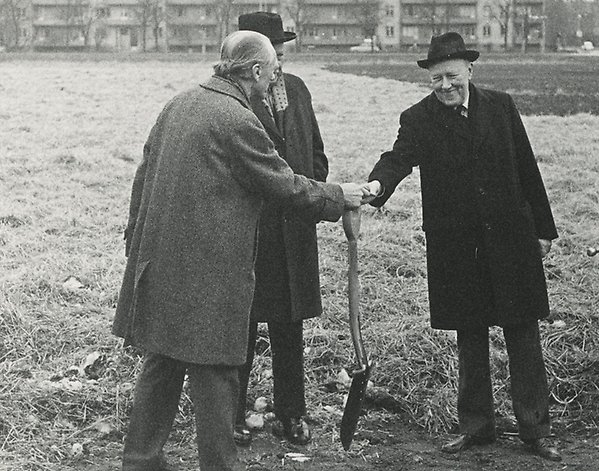Torgny T. Segerstedt

Torgny Segerstedt (on the right) takes the first sod before the construction of the Humanistcentrum, now Ekonomikum, in 1974. From the left: building director Sven Gellerstedt and builder Anders Diös.
Torgny T. Segerstedt was Vice-Chancellor of the University between 1955 and 1978. Segerstedt’s time as Vice-Chancellor was eventful and included the extensive modernisation of the Swedish system of higher education, not least the 1964 statutory instrument for universities and the 1977 university reform. In the course of these 23 years, more students were admitted than during the entire prior history of Uppsala University, i.e. from 1477 to 1955. New student housing areas were built, new teaching positions were established and the department model took shape. Segerstedt chaired the Universities Inquiry, which led to the establishment of university lectureships. In Uppsala, large facilities were built, such as BMC and the Centre for the Humanities and Social Sciences (later Ekonomikum). All of this meant entirely new challenges for the University’s administration, which from 1964 was led by a special university counsellor (later the University Director).
Torgny T. Segerstedt was born in 1908, the son of Torgny Segerstedt the elder, legendary editor-in-chief of the newspaper Göteborgs Handels- och Sjöfarts-Tidning, and his wife Augusta Wilhelmina Synnestvedt. Segerstedt the younger studied in Lund, Paris and London. He earned his PhD and became a docent in philosophy in Lund at the age of 26 in 1934. Just over four years later, on New Year’s Day in 1939, he took up the professorship in practical philosophy in Uppsala, which was the beginning of a 60-year period of involvement at and around Uppsala University. Segerstedt was independent of the various schools of philosophy in Uppsala at the time. He belonged neither to the older school of idealism nor to analytical philosophy. He can rather be characterised as a historian of philosophy or historian of ideas, with a focus on psychological and sociological questions.
In the summer of 1947, after eight and a half years as a professor of philosophy, Segerstedt moved to a newly established professorship in sociology. In contrast to the subject of philosophy, within which Segerstedt was caught between different camps, as a professor of sociology he was able to build his own subject from the ground up. Earlier sociology in Sweden had had a theoretical focus, but Segerstedt combined theory with empirical methods. He was especially interested in social norms and the changed conditions brought by industrialism in Sweden.
From the beginning of the 1950s onwards, Segerstedt was given more and more administrative responsibilities, including being Dean of the Faculty of Arts. As Vice-Chancellor, Segerstedt became a powerful leader figure for Uppsala University. He did not hesitate to express his views in speeches at academic ceremonies, and he took an active part in social debate. During the radical years around 1968, he defended the University’s time-honoured ceremonies, which were called into question in some quarters. In the 1950s, he himself introduced the tradition of the donning of the caps on the balcony of Carolina Rediviva at 15:00 on Walpurgis Eve. Segerstedt was deputy inspector from 1967 and inspector from 1972 of Norrlands nation student association, the only non-Norrland native to have held the position.
During his time as Vice-Chancellor, Segerstedt wrote several works on the history of philosophy, which in 1975 qualified him for election to the Swedish Academy. He participated actively in its work and, among other things, published the three-volume work Svenska Akademien i sin samtid (1986–92) [The Swedish Academy in its time (1986–92)]. The first two volumes were published for the Academy’s bicentennial in 1986. Segerstedt was a member of several other academies, including the Royal Swedish Academy of Sciences.
In 1974, Segerstedt was re-elected Vice-Chancellor of Uppsala University for the sixth time. This time, it required a special government decision. Segerstedt was thus able to lead the University over its great 500th anniversary in 1977. He retired the following year and was succeeded by Martin Henriksson Holmdahl. In the ensuing 20 years, Segerstedt remained involved in the University and its affairs. He died in January 1999, a few months after his 90th birthday.
In his honour, Uppsala University established the Torgny Segerstedt Medal, which is awarded every two years to Swedish researchers who have made prominent contributions in the humanities and social sciences. The medal was first awarded in 1988.
Segerstedthuset, the Segerstedt Building, which was built to house Uppsala University’s administration and opened in the summer of 2017, is named after Torgny T. Segerstedt.
